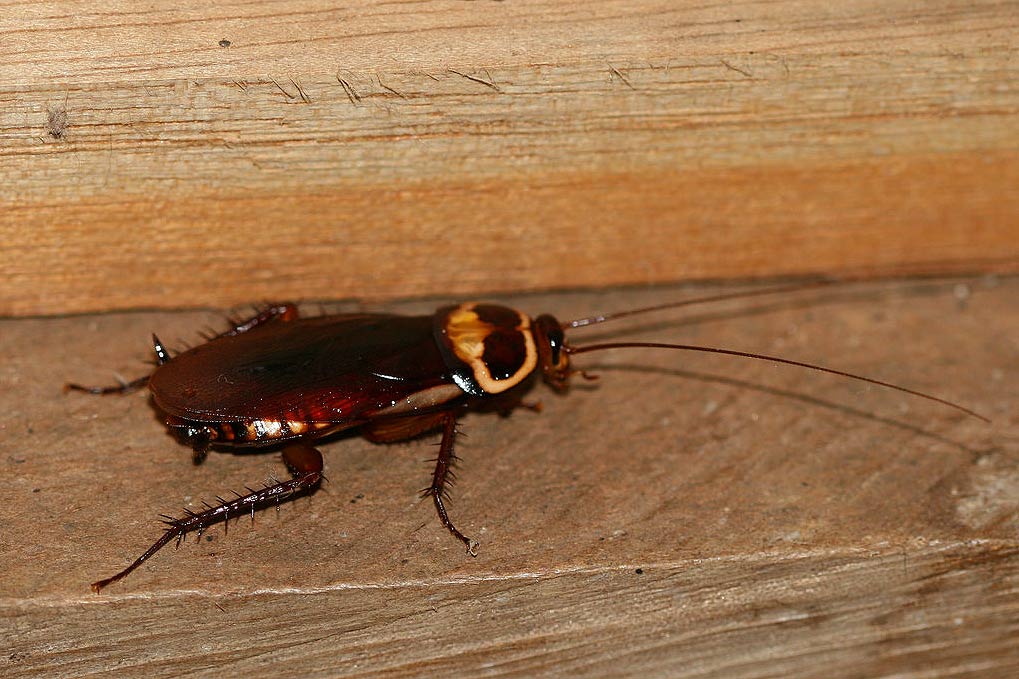Cockroach
Cockroaches are insects belonging to the order Blattodea
Cockroach
Friend or Foe? The general form of cockroaches varies little, however their size can range from only a couple of millimetres in length up to 70 millimetres for the Giant Rhinoceros cockroach, which lives in Northern Queensland. There are just over 400 species in Australia out of 4000 worldwide, the best known being the introduced pests which commonly inhabit houses, restaurants and sewers.
All cockroaches have the following characteristics:
* Oval and flattened shape
* The thorax is covered by a large plate (the pronotum), which extends partly over the head
* Chewing (mandibulate) mouthparts.
* Compound eyes and 2 simple ocelli-like spots
* 2 pairs of membranous wings when present. The forewings are more sclerotised than the hind wings. Wings are folded left over right when at rest
* Prominent cerci
* Long antennae
Almost all species in the Blattidae family are flightless except for Methana species. Species in the Blattidae family range from black and brown to red in colour, but a few are even iridescent green. Some species have distinctive bands or spots, while others such as Methana marginalis have pale borders. Some species in the Blattidae family are of economic importance, such as the American cockroach Periplaneta americana which is an introduced pest species commonly found in and around human habitation. Methana marginalis is a native species found throughout Queensland. It has been introduced to Norfolk Island where it has become a pest, by invading homes and gardens.
Life Cycle
Cockroaches have incomplete metamorphosis. Most species of cockroaches lay eggs in an ootheca (egg case) that is either deposited on or under suitable substrate, or carried attached to the genital region. The egg stage lasts from a few weeks to a few months. The young are active from hatching and resemble the adults, but are usually lighter in colour and lack wings. The young cockroaches develop through a number of nymphal instars, which may range from 2 to 12 depending on the species and may take from a month or so up to 12 months to reach maturity. Some species may live for several years.
Feeding
Much of the feeding habits of native Australian cockroaches is unknown, but it is likely the majority are omnivorous. Some species are known to feed predominantly on rotting wood, while some species harbour symbiotic gut Protozoa that aid in cellulose digestion. The introduced domestic species appear to eat almost anything.
Habitat
Cockroaches in Australia are widespread and adapted to both wet and dry environments. Most species are nocturnal and ground dwelling and are usually found hiding during the day in crevices, under bark, rocks or logs and in burrows. Some species may occur on plants or in litter and some also occur solely in caves or ant nests. Others are associated with human habitation.
Geoscapheus dilatatus (Blaberidae)
Blaberidae is the second largest family of cockroaches worldwide, although Australia has few species.
Many species, such as Geoscapheus dilatatus, are adapted for burrowing in soil, having robust body shapes and short powerful legs.
Also belonging to this family is the giant rhinoceros cockroach, Macropanesthia rhinoceros, which lives in northern Queensland. This cockroach is the largest in the world and can weigh up to 30 grams. It can live for several years and is sometimes kept as a pet.
Go to this page to read about cockroaches:

